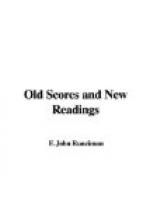or Mackenzie would have made of it! And then think
of what the “Ring” actually is, and especially
of the splendour and weirdness of some parts the “dulness”
of which moves dull people to dull grumbling.
For example, a great many persons share Mime’s
wish for the Wanderer to go off almost as soon as
he comes on, “else no Wanderer can he be called.”
They tell us that this scene breaks the action, neglecting
the trifling fact that were it omitted the remainder
of the act would be inconsequent nonsense, only worthy
to rank with the librettos of English musical critics,
and that the truth happens to be that nearly the whole
of the subsequent drama grows out of it. In itself
it is a scene of peculiar power, charged to overflowing
with the essence of the Scandinavian legends.
The notion of the god, “one-eyed and seeming
ancient,” wandering by night through the wild
woods, clad in his dark blue robe, calling in here
and there and creating consternation in the circle
gathered round the hearth, is one of the most poetic
to be found in the Northern mythology; and the music
which Wagner has set to his entry and his conversation
cannot be matched for unearthliness unless you turn
to the Statue music in “Don Giovanni,”
where you find unearthliness of a very different sort.
The scene with Erda in the mountains is even more
wonderful, so laden is the music with the Scandinavian
emotional sense of the impenetrable mystery of things.
The scene between Mime and Alberich, or Alberich and
the Wanderer, gives us the old horror of the creeping
maleficent things that crawled by night about the
brooks and rock-holes. It is true this last will
bear cutting a little; for Wagner being a German,
but having, what is uncommon in the German, an acute
sense of balance of form, always tried to get balance
by lengthening parts which were already long enough,
in preference to cutting parts that were already too
long. Hence much padding, which a later generation
will ruthlessly amputate.
All these things are the accessories, the environment,
of the principal figure; and their presence is justified
by their beauty, significance, and interest, and also
by their being necessary for the development of the
larger drama of the whole “Ring.”
But in following “Siegfried” that larger
drama cannot altogether be kept in mind: it is
the hero that counts first, and everything else is
accessory merely to him. That Wagner, in spite
of his preoccupation with the tragedy of Wotan, should
have accomplished this, proves how wonderful and how
true an artist he was. Siegfried is the incarnation,
as I have said, of the divine energy which enables
one to make the world rich with things that delight
the soul; he is Wagner’s healthiest, sanest,
perhaps most beautiful creation; he is certainly the
only male in all Wagner’s dramas who is never
in any danger of becoming for ever so brief a moment
a bore, whose view of life is always so fresh and novel
and at the same time so essentially human that he interests




